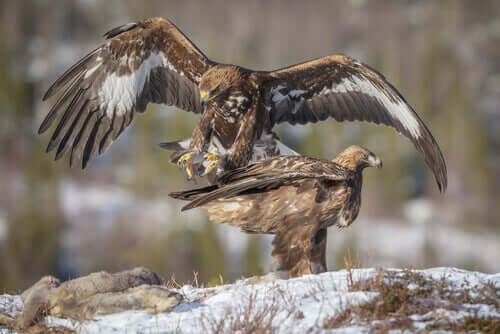The Conservation of Eagles in Spain

Why is the conservation of Eagles so important in Spain? Both Bonelli’s eagle (Aquila fasciata) and the golden eagle (Aquila chrysaetos) represent the image that Spaniards have of great eagles. They inhabit the mountains and bluffs of the country’s most rugged regions. Both are elegant and majestic in flight and hunt and trap their prey between their powerful claws. And, finally, they are a symbol of Spain’s wildlife.
However, misinformation and lack of knowledge caused many to consider the eagle to be an enemy and competitor to humans. And this ignorance has lead to their extermination, which is why their conservation is so important today.
The conservation of Spanish eagles
The increasing knowledge of Spain’s wildlife has contributed to a greater awareness of the need to preserve their natural patrimony. The years when Spain rewarded the deaths of these raptors have, thankfully, long gone.
The attempts to do away with these species were fortunately unsuccessful. In fact, to this day, Spain continues to possess the largest Bonelli’s eagle and golden eagle populations in all of Europe. However, there is still a great battle to be won. Approximately 80% of specimens born of both species fail to reach reproductive age. What’s more, a high percentage of adult eagles die each year.
General information regarding both species
The golden eagle
The golden eagle, whose scientific name is Aquila chrysaetos, is, without a doubt, one of the most extraordinary birds to fly in Spanish skies.

Population and distribution
The population of Spain’s golden eagle is the greatest in all of western Europe. However, they’re experiencing a concerning reduction and an irregular distribution throughout the peninsular region. There are some 1200 reproductive pairs left in the country, with some 5000 couples in all of Europe.
In the Iberian peninsula, their territory is located in the areas that are most mountainous and least inhabited by humans. Perched upon a rock or the branch of a tree, they spend the majority of the day inactive… watching over their domain.
Diet
The golden eagle enjoys a varied diet, 70 to 90% of which consists of small mammals–especially rabbits and hares. They also consume reptiles and small birds. They have no problem eating animals that are already dead. In fact, it’s not uncommon to spot them circling over these dead carcasses for some time in order to ward off vultures.
Bonelli’s eagle
The scientific name of this Spanish eagle is Aquila fasciata. These birds are medium in size and are typical of Spain’s mountainous areas. Their wingspan is approximately 5 feet, 7 inches and they can weigh up to 5.5 pounds. This is especially true in the case of females.

Distribution
In Europe, there are approximately 900 pairs of Bonelli’s eagles. The most significant reproductive nucleus is located in Spain, with some 750 reproductive pairs. Most of them inhabit the Subbetic and Penibetic mountain ranges, the Iberian mountain system, and the Sierra Morena.
Bonelli’s eagle is a sedentary raptor that places its nests in mountainous regions with a low altitude. It’s aggressive and requires large territorial dominions. Therefore, it expels large vultures whenever they invade its territory.
Diet
These eagles are distinguished hunting birds that aren’t known to behave as scavengers. Their diet consists of prey that weighs less than 13 pounds–especially rabbits, pigeons, partridges, crows, and large reptiles.
Given their flight ability when it comes to capturing birds, this is a very valuable species for controlling the crow population.
The conservation of eagles in Spain
The problems
The greatest problems facing eagles in Spain are the following:
- The alteration of their habitat by human beings
- An increase in mortality due to electrocution, shooting, poison, and plundering
- A reduction in sources of nutrition as a result of a decline in rabbit populations
- The impact of certain outdoor human activities, such as rock climbing
The following measures can help preserve eagle populations in Spain:
- Guaranteeing peace around nest sites during the reproductive season
- Reducing the non-natural mortality rate
- Guaranteeing optimal populations of natural prey
All cited sources were thoroughly reviewed by our team to ensure their quality, reliability, currency, and validity. The bibliography of this article was considered reliable and of academic or scientific accuracy.
- El águila perdicera y el águila real. Colección GREFA-BCH, Nº 7.
